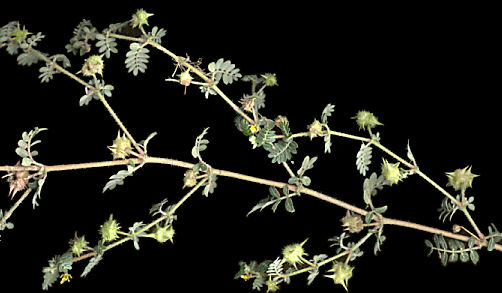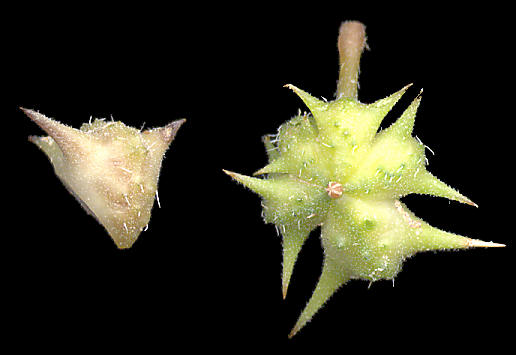

Ravioli, olive oil, and the sexy movie star of your choice are just a few of the Mediterranean region's contributions to life in our desert. Without intending to insult that part of the world, we might add that it also gave us puncturevine, also known as bullhead, goathead, Mexican sandbur, caltrop, and Texas sandbur.
Some of the common names may clue you in to the nature of the gift. The plant itself, a relative of the creosotebush, is not ugly with its trailing stems and small, yellow flowers. What surpasses ugly is its fruit, with its four pairs of stout, radiating spines. These are not the sissy spines of a cactus or silver-leaf nightshade—these are industrial-strength instruments of torture. Even the tough rubber of bicycle tires is outclassed, let alone the tender feet of man and beast. Not content to attack as a unit, the fruit eventually breaks into four parts, all armed and dangerous.
Extracts of puncturevine are sold to supposedly enhance marital
relations. Don't you think you'd have to be rather naive to trust anything this
vicious?

Contributor: Arthur H. Harris, Laboratory for Environmental Biology, Centennial Museum, University of Texas at El Paso.
Desert Diary is a joint production of the Centennial Museum and KTEP National Public Radio at the University of Texas at El Paso.

Part of a Goathead (Tribulus terrestris). In life, this would be lying flat on the ground. Abundant fruits can be seen. Scanned image by A.H. Harris.

Goathead seeds. The entire fruit before it fragments into segments is seen on the right; on the left is an oblique view of one segment after fragmentation. Scanned image by A.H. Harris.
Puncturevine. Good pictures and text.
Wayne's Word. More good pictures.